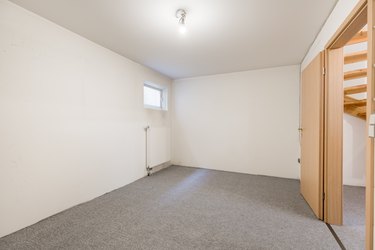
A basement that's going unused because of its unfinished state or downright scary atmosphere is living space waiting to come alive. Invigorate a cold, unfriendly, or spine-chilling area's persona with area rugs, plush furniture, plenty of pillows — and fabric on the walls. Hang textiles in one of a few basic ways, but only after you make sure the space is fabric-friendly.
Stop Moisture First
Video of the Day
When fabric and dampness get together, mold is born — and a moldy basement is not a healthy place to hang out. Before hanging fabric on basement walls, rectify any moisture issues. If the space is too humid simply because of temperature changes or dankness, a space heater or dehumidifier should help; for serious dampness or mustiness, look at improving ventilation.
Video of the Day
If water seeps through wall or floor cracks, filling them with hydraulic mortar may only provide a bandage; the exterior walls might need to be resealed, or the drainage improved, such as with drain tile to carry rainwater away from the foundation.
Create Walls With Curtains
Curtains aren't just for windows — you can think of them also as ready-to-hang fabric walls. Although masonry wall anchors provide a secure connection for mounting curtain rods on concrete or block walls, look up for another option. You may be able to screw ceiling-mount drapery rods to the wood joists overhead. This is much easier than drilling into concrete.
If ceiling-to-floor curtains are sufficiently full and thick, they create an almost insulation-like warmth, blocking at least some of the chill that can come from unfinished walls and disrupt your low-level retreat's comfort.
Glue Fabric to the Walls or Insulation
Crinkly fabric-covered walls look much homier and more chic than rough, exposed concrete. Liquid fabric starch acts as the glue to secure fabric panels to the wall in wallpaper-like fashion. Mix things up by using a patchwork or wall-tile design of pleasantly contrasting patterns and colors. Paint gray concrete white, so it won't discolor semi-transparent material.
Alternatively, adhere fabric smoothly to lightweight foam-insulation panels, and mount the panels to the wall with construction adhesive, or use removable fasteners or double-sided tape for a more temporary wall treatment. This effect can appear more prim than crinkled fabric, and the foam helps keep the room warmer.
Hang Panels With Staples
In a partly finished basement with framed walls, but no drywall, you can staple fabric directly to the exposed studs. Measure and cut the fabric panels a little long — you can trim any excess from the bottoms when they're in place. Work from a corner out and from the top down, until the wall is fully covered.
If you prefer a draping effect, wrap the top end of each fabric panel around a 1x2 wood strip, and mount the strip end-to-end along the top of the wall. Weight the panel bottoms or tack them to studs to keep the fabric flat.